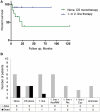Anti-IgLON5 Disease: A Case With 11-Year Clinical Course and Review of the Literature
- PMID: 31632341
- PMCID: PMC6783555
- DOI: 10.3389/fneur.2019.01056
Anti-IgLON5 Disease: A Case With 11-Year Clinical Course and Review of the Literature
Abstract
Background: Anti-IgLON5 disease is a novel disorder with a complex interplay between inflammation and neurodegeneration. Patients develop antibodies against IgLON5 but also deposition of neuronal tau protein. Symptoms often have an insidious onset, slow progression and mimic other neurological disorders. Here we report a case with severely prolonged 11-year disease course and provide a review of current reported cases with focus on presentation, work-up, treatment, and outcome. Method: All reported cases of anti-IgLON5 disease were evaluated. Cases reported twice (in case series and as single case reports), were carefully excluded. Results: Most patients display a characteristic sleep disorder with severe insomnia, non rapid eye movement (NREM) parasomnia, with finalistic movements and sleep disordered breathing (stridor and obstructive sleep apnea). Other symptoms are bulbar involvement, gait instability, movement disorders, oculomotor abnormalities, dysautonomia, and peripheral symptoms. Antibodies are present in both serum and CSF and there is a strong correlation with human leukocyte antigen (HLA) DRB1*10:01 and HLA-DQB1*05:01. Neuropathological examination reveals neurodegeneration with neuronal tau deposits in regions that correlate with the clinical presentation (e.g., predominantly hypothalamus and tegmentum of the brain stem). Majority of cases respond partially to immunotherapy. Cases, who received no treatment or treatment with IV corticosteroids alone, had a higher mortality than cases treated with more potent immunotherapy. Conclusion: The clinical spectrum of Anti-IgLON5 disease continues to expand. Further studies are needed to elucidate the pathophysiology, therapeutic strategies and outcome in this novel disorder. Aggressive immunotherapy seems to increase survival.
Keywords: IgLON5; autoimmune encephalitis; immunology; inflammation; tau.
Copyright © 2019 Nissen and Blaabjerg.
Figures


References
-
- Sabater L, Gaig C, Gelpi E, Bataller L, Lewerenz J, Torres-Vega E, et al. . A novel non-rapid-eye movement and rapid-eye-movement parasomnia with sleep breathing disorder associated with antibodies to IgLON5: a case series, characterisation of the antigen, and post-mortem study. Lancet Neurol. (2014) 13:575–86. 10.1016/S1474-4422(14)70051-1 - DOI - PMC - PubMed
Publication types
LinkOut - more resources
Full Text Sources
Research Materials

